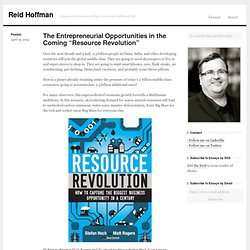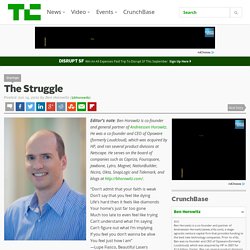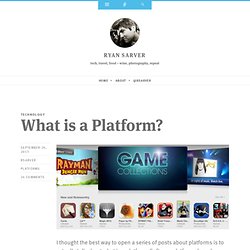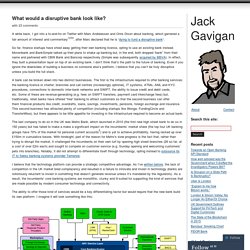

Board Observers Weekly - April 15th, 2014. When You're at the Crossroads of Should and Must. The Entrepreneurial Opportunities in the Coming “Resource Revolution” Over the next decade and a half, 2.5 billion people in China, India, and other developing countries will join the global middle class.

They are going to need skyscrapers to live in and super-stores to shop in. They are going to want smartphones, cars, flank steaks, air conditioning, pet clothing, Disneyland vacations, and probably some throw pillows. How is a planet already straining under the pressure of today’s 2 billion middle-class consumers going to accommodate 2.5 billion additional ones? For many observers, this unprecedented economic growth foretells a Malthusian meltdown. In this scenario, skyrocketing demand for scarce natural resources will lead to unchecked carbon emissions, water wars, massive deforestation, $100 Big Macs for the rich and cricket-meat Bug Macs for everyone else. McKinsey director Matt Rogers and Stanford professor Stefan Heck have a more optimistic take on the future. Fred Wilson Interview. The Struggle. Editor’s note: Ben Horowitz is co-founder and general partner of Andreessen Horowitz.

He was a co-founder and CEO of Opsware (formerly Loudcloud), which was acquired by HP, and ran several product divisions at Netscape. He serves on the board of companies such as Capriza, Foursquare, Jawbone, Lytro, Magnet, NationBuilder, Nicira, Okta, SnapLogic and Tidemark, and blogs at “Don’t admit that your faith is weak Don’t say that you feel like dying Life’s hard then it feels like diamonds Your home’s just far too gone Much too late to even feel like trying Can’t understand what I’m saying Can’t figure out what I’m implying If you feel you don’t wanna be alive You feel just how I am” —Lupe Fiasco, Beautiful Lasers Every entrepreneur starts her company with a clear vision for success. You will create an amazing environment and hire the smartest people to join you. Then, after working night and day to make your vision reality, you wake up to find that things did not go as planned.
The end. Steve Jobs’s Real Genius. Not long after Steve Jobs got married, in 1991, he moved with his wife to a nineteen-thirties, Cotswolds-style house in old Palo Alto.

Jobs always found it difficult to furnish the places where he lived. His previous house had only a mattress, a table, and chairs. He needed things to be perfect, and it took time to figure out what perfect was. This time, he had a wife and family in tow, but it made little difference. “We spoke about furniture in theory for eight years,” his wife, Laurene Powell, tells Walter Isaacson, in “Steve Jobs,” Isaacson’s enthralling new biography of the Apple founder. It was the choice of a washing machine, however, that proved most vexing. What is a Platform? I thought the best way to open a series of posts about platforms is to actually talk about what is a platform.

Software platforms have been around for a long time and many of the same principles and dynamics apply across the changing times and technologies. I want to start off by recommending some homework. I found a book early in my time at Twitter, called Invisible Engines, that helped me greatly in understanding the dynamics and economics of platforms. A lot of how I think about platforms was shaped by that book and you’ll see many of the concepts repeated here. While it looks long, you can focus on a few key chapters to make it an easy read.
Now, let’s go back to June of 2007 — the iPhone has just launched. “Most successful software platforms have exploited network effects between applications and users: more applications attract more users, and more users attract more applications.” — Invisible Engines An example of a platform with strong network effects is iOS. What would a disruptive bank look like? A while back, I got into a to-and-fro on Twitter with Marc Andreessen and Chris Dixon about banking, which garnered a fair amount of interest and commentary1234, after Marc declared that he is “dying to fund a disruptive bank“.

So far, finance startups have shied away getting their own banking licence, opting to use an existing bank instead. Movenbank and BankSimple talked up their plans to shake up banking but, in the end, both dropped “bank” from their name and partnered with CBW Bank and Bancorp respectively (Simple was subsequently acquired by BBVA). In effect, they built a presentation layer on top of an existing bank. I don’t think that’s the path to the future of banking.
Even if you ignore the downsides of building a business on someone else’s platform, I believe that you can’t be truly disruptive unless you build the full stack. A bank can be broken down into two distinct businesses. I believe that the technology platform can provide a strategic competitive advantage. Like this: